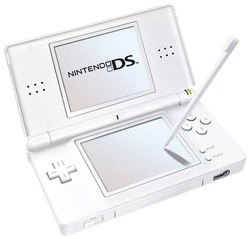Nintendo DS
| ニンテンドーDS Nintendo DS | |
 Lite model | |
| Release dates | |
| Japan | December 2, 2004 |
|---|---|
| North America | November 21, 2004 |
| Europe | March 11, 2005 |
| Technical information | |
| Display | Two TFT LCDs, 256 × 192 pixels |
| Media | Nintendo game card, ROM cartridge |
| Other information | |
| Console generation | Seventh generation |
| Console type | Handheld console |
| Successor | Nintendo 3DS |
The Nintendo DS (Japanese: ニンテンドー DS Nintendo DS), often shortened to just DS, is Nintendo's fifth series handheld console, succeeding the Game Boy Advance. Released in the seventh generation, the Nintendo DS represented an experimental new era for Nintendo's game consoles.
History
Unlike previous handheld systems, the Nintendo DS does not use the "Game Boy" moniker, often believed to be due to Nintendo not wanting to tarnish the brand name in case of bad sales, as had happened with the earlier Virtual Boy. The system was named "DS" as an initialism of "Developers' System" or "Dual Screen". The DS was originally intended to be a partner to the Game Boy Advance instead of a replacement.
Despite this being the initial strategy, the DS in fact did become the official replacement to the Game Boy Advance, and as such concluded the lifespan of said system. The most signifficant difference is the second screen, which caused developers and gamers alike to move on the the new system. The second screen featured a touch-sensitive screen, which could be used to navigate menus and select items. The console also included more "standard" upgrades from the Game Boy Advance, such as an improved backlight, built in microphone, as well as a second speaker to better play stereo sounds.
As of September 2008, combined sales of Nintendo DS and Nintendo DS Lite have reached more than 84 million units worldwide. By the end of January 2010, that number increased to over 125 million units sold worldwide, making it Nintendo's best selling console of all time.
Hardware
DS games are played using DS cards which are inserted into the top slot. The DS featured the inclusion of wireless communications, which allowed games to communicate with each others' DS consoles, without the need of wired connectors such as the Game Link Cable . Wireless communication allowed certain DS games to connect to the internet and communicate with other DS systems worldwide using the Nintendo WFC feature.
The DS also included a second bottom slot which features backwards compatibility with Game Boy Advance games, with gamers able to select using the DS menu whether to play using the top or bottom screen, though the touch screen is disabled. Multiplayer features are not supported for these games due to the lack of a Game Link Cable port. Most GBA games released during this era were also labeled as being playable on the DS, such as Mother 3. Game Boy and Game Boy Color games are not playable, as the processor that runs them is not included in the system, as such the bottom slot can only read GBA games.
Similar to Nintendo's previous handheld systems, a revision of the Nintendo DS was released in 2006 known as the Nintendo DS Lite. Often referred to as the "lighter and brighter DS", this revision features a smaller smoother design and is noticeably lighter in weight. The backlight was also further improved and allowed for varying brightness settings as opposed to the simple on-off light used on the original DS, referred to as the "DS Phat" by fans. In early 2007 this revision became the replacement model and the original DS was discontinued, leaving the DS Lite as the only DS console distributed for a time.
EarthBound games
The following EarthBound series games can be played on the Nintendo DS:
- Mother 1+2 (Japan only): Released in 2003 before the DS era, it can still be played via backwards compatibility.
- Mother 3 (Japan only): Released in 2006 during the DS era, it can be played via backwards compatibility. Using a flash cartridge allows for the fan translation to be played on the DS.
Nintendo DSi
The Nintendo DSi (Japanese: ニンテンドー DSi Nintendo DSi) is an enhanced model to the Nintendo DS. Released in November 2008 in Japan and April 2009 in western countries, the system features a redesigned menu which allow for more software to be downloaded. A camera was also added, which allows gamers to take digital photos which can be viewed and featured in games. An SD card slot allows for transfer of photos and music between DSi, Wii, PC and digital cameras.
Unlike previous handheld systems, the Nintendo DSi is region locked. Some games released were DSi enhanced and are region locked. The DSi itself recieved an upgrade known as the Nintendo DSi XL, which is larger and features a larger screen. The GBA slot was removed from the DSi models, as such no EarthBound games can be played on the DSi.
| Systems with EarthBound and Super Smash Bros. games. |
|---|
| Home consoles NES • SNES • N64 • GCN • Wii • Wii U • Nintendo Switch Handheld consoles GBA • DS • 3DS • Nintendo Switch |